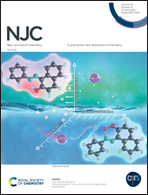Theoretical insights into the photovoltaic properties of ruthenium(ii) bipyridyl photosensitizers through variation of the anchoring groups†
Abstract
In this study, eleven Ru-based dyes have been theoretically designed by substitution of different anchors. Their light harvesting capability in dye-sensitized solar cells (DSSCs) and non-linear optical (NLO) properties were subsequently explored. The structural, optoelectronic and NLO properties of these Ru(II) complexes are analyzed using density functional theory (DFT) and time-dependent density functional theory (TD-DFT) methods in both the gas phase and acetonitrile. The results illustrate that the changing of the anchoring groups on the bpy ligand of complex [Ru(bpy)2(NCS)2] could reduce the energy gap (Eg), redshift the maximum absorption wavelengths (λmax), increase the oscillator strength (ƒ) and light-harvesting efficiency (LHE), and enhance the driving force of injection (ΔGinj), thus amplifying the efficiency of the DSSC. According to the results, the presence of nitro (–NO2) anchors in the complex [Ru(bpy)2(NCS)2] (Ru-dye 8) led to a reduction in open circuit voltage (Voc = 0.45 eV), while significantly decreasing the energy gap (2.05 eV) and notably increasing the excitation wavelength (657 nm). Ru-dye 9 exhibited the largest static first hyperpolarizability (β0 = 273 × 10−30 e.s.u.) compared to the other Ru-dyes. This study provides valuable insights into the understanding of Ru-based dyes in DSSC devices and NLO materials.



 Please wait while we load your content...
Please wait while we load your content...